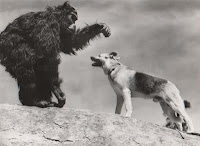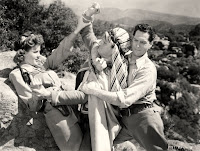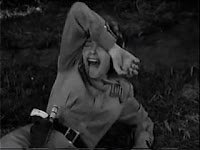 NOTE: There are a
couple of small spoilers included here, but frankly, it doesn't
matter.
NOTE: There are a
couple of small spoilers included here, but frankly, it doesn't
matter.
There must be
something about the lockdown; it's not as if my life, which is
primarily working from home, has changed immensely—yes, shopping
takes longer and there's nowhere to go except for walking the dog—but
sometimes I think I have bugged out to a fantasy world set in my
parents' youth. I've always loved the Thirties and Forties, so it
isn't that strange—but it may seem weird that for each of the last
15 days I have set aside 15 minutes or so to watch one chapter each
day of The Perils Of Nyoka, a Republic Pictures serial from 1942.
Serials were run for kids on Saturday afternoons in cinemas all over
America; I suppose lockdown evenings are the next best thing, and I
doidn't have to wait a week for the next episode.
I know how I got to
Nyoka. I had been watching a lot of series B pictures in the vein of
The Saint. So I spotted Lorna Gray playing a bit part in The Lone
Wolf Spy Hunt (1939), distracting Warren William away from persistent
girlfriend Ida Lupino and femme fatale Rita Hayworth (trust me, she
could do it), then a week later caught a similar eye-catching cameo
from Kay Aldridge modelling a V for Victory gown in The Falcon's
Brother (1942). Checking their credits, I realised they had both
appeared in the Nyoka serial, so I found it on You Tube and took a
look. Of course I was hooked.
Nyoka was later
re-issued as Nyoka and the Tiger Men, which is odd as there aren't
really many tiger-men in it, and no tigers. It was also re-edited
into a feature in 1966, under the title Nyoka and the Lost Secrets of
Hippocrates, which is closer to the truth, but not very catchy. I
wouldn't be surprised if they were trying to cash in on the campy
Batman TV show craze.

Aldridge plays
Nyoka, a character who had starred (played by Frances Gifford) in the
serial
Jungle Girl, based on an Edgar Rice Burroughs novel, but
bearing no relationship to the book at all. And Aldridge's Nyoka
bears even less. She's not a jungle girl at all, but living in what
appears to be Abyssinia, in a sub-desert setting which is the
California of countless B movie westerns. She is part of a team
searching for the Golden Tablets of Hippocrates, which contain a cure
for cancer—but also contain directions to a treasure, which means
they are coveted by Vultura, Queen of the Arabs. She is also
searching for her father, who was lost and presumed dead on a similar
previous expedition.
Nyoka's team
includes Dr Larry Grayson, a medical doctor who's pretty handy with
gun and fists, and played by Clayton Moore, who later achieved fame
as the Lone Ranger. Moore actually packs a pretty good left hook; he
brawls with great energy which is essential to any serial. Billy
Benedict plays his pal Red, accompanied by a monkey called Jitters,
played by a monkey called Professor. There are some veteran actors in
the professorial parts, all of whom are getting by, and oddly, when
Nyoka does discover her father, Professor Gordon, who is now high
priest of the Tuareg tribe, she doesn't recognise him, but recognises
his signet ring!

The villainess is
Vultura, a priestess played by Gray. She's aided by Cassib, whose
tribe of Arabs follows her. Cassib is played by Charles Middleton,
who you will remember as Ming the Merciless in the Flash Gordon
series: he delivers his few lines with real panache, and despite
seeming visibly too old for the rough stuff, takes part in any number
of brawls.
They also add Signor
Torrini, played by Tristam Coffin, whom I remembered from a western
TV series called 26 Men, also starring the immortal Kelo Handerson.
He also played Jeff King in a 1952 Republic serial King Of The
Rocketmen, which was then followed by Radar Men From The Moon, also
in 1952, in which King had been re-named Commando Cody (played by
George Wallace, no not the Georgia governor, but arguably the most
wooden actor in history) and in which Clayton Moore also has a role,
as a villain in the service of the Moon Men. Small world! Coffin
actually may be the best actor in this crowd, but his role is
severely limited, despite Torrini's representing the Italians who are
in charge of Abyssinia, and being in a fact a spy for Vultura.
The problem with
trying to judge acting in a serial is that there is not much of it
written into the scripts, and what is written in is not written well.
Remember the audience was mostly young boys on Saturday afternoons,
so lines are simple, and exist to explicate elements of the plot an
over popcorn'd, candied and soda'd 12 year might follow. In other
words, what TV today assumes is the level of its basic adult
audience. As I said Coffin stands out, trying to look evil while
ingratiating himself with the party. Aldridge tries too,but she really has
very little to work with, and she hesitates over her few good lines.
Gray is fine as a villain; her femme fatale potential is clear.In 1945 she changed her screen name to Adrian Booth, but her career never advanced beyond B pictures; I can think of a handful of more major act

But the best actor
in the serial is actually Ace, the dog who plays Nyoka's dog Fang.
Oddly, he just disappears in the last couple of episodes; maybe he
got a better offer from another adventure film. I should also mention
Emil Van Horn, who plays Satan the gorilla. Satan's death scene is
actually the most moving bit of drama in all 15 chapters, and I felt sorry for the
big guy.
Also in the cast are
Yakima Canutt, whose stunts you can see, and Clayton Moore's future
Tonto, Jay Silverheels. I didn't check the cast until after I'd
finished the series, so I can't say as I spotted either of them, but
you don't get much chance, because the use of close ups is extremely
limited. I don't know if you've seen a serial, but you probably know
that each chapter ends with a cliffhanger (the word comes from the
original serials) in which one of the leads appears to headed for
sure death. It never turns out that way. There's only one or two in
Nyoka that are real cheats, like when she falls off a cliff and then
next week when she falls she has a rope in her hands. Which is a literal cliffhanger.
I'd seen Flash
Gordon, but in the edits done for Saturday morning syndicated TV in
the Fifties. I also saw the Commando Cody TV series, with Judd
Holdren as Cody, and probably also Lost Planet Airmen, which was the
Tris Coffin serial re-edited into TV episodes. They're somewhat
harder going than this one. But my favourite things in them were the
trash-can helmet Cody wore, his leather jacket which was his flying
gear, and the control panel for his rocket pack, which boasted an
on/off switch and two controls: up/down and fast/slow. NASA took
years to catch up to this.

The production
values and cast of Nyoka are pretty good, in fact often considered
the best of the serial era. The story is pretty basic, with the
possibilities of greater intrigue with Torrini, greater dramatic
tension with Nyoka's long-lost father, and any femme-fatality at all
(since 12 year old boys weren't interested in that mushy stuff) lost.
Any episode moves between Vultura's temple, Cassib's village, Nyoka's
bedouin village, and the Tuareg temple. Directions to the Golden
Tablets and given by those tablets all seem to involve places within
a ten minute ride of each other, and reach episode features at least
three scenes where groups of tribesmen are galloping off from one to
another. Then they get ambushed and a gun fight ensues. Occasionally
there is a chase, and in every episode at least one brawl. These can
be funny: fighters fall unconscious, then spring up as if on signal
fully awake and fit. Aldridge is particularly bad at trying to look
natural when she's knocked cold into a precarious position. And in
one episode,

the bedouin who is shot and falls off a balcony, misses
the lamp that's supposed to start the fire that traps Larry and Red,
so he rolls an extra, unconscious, step, to knock the lamp over!
I was oddly
disappointed with the final episode. Yes, cancer was now going to be
cured forever, but what about Nyoka and Larry? And where was Fang? Maybe if we weren't locked down I would not have minded, but I certainly
can't blame the lockdown for enjoying this trip back to a different
childhood. And had I seen it as a child, I probably would not have
appreciated either Kay Aldrdige or Lorna Gray half as much.














